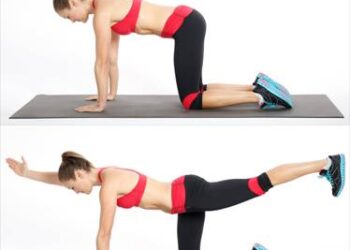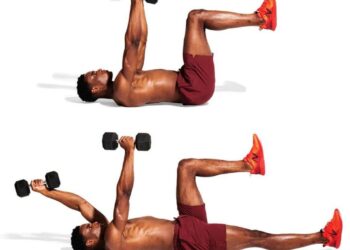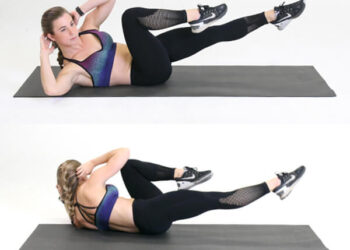1. Increasing Exercise Difficulty
1.1. Adding Resistance
- Weight Training: Incorporating weights or resistance bands into exercises increases the workload on muscles, promoting strength and muscle growth. Exercises like squats, lunges, or push-ups can be performed while holding weights or using resistance bands for added difficulty.
- Household Items: Utilize household items like water bottles, backpacks filled with books, or cans to add resistance during workouts. For instance, holding these items while doing lunges or shoulder presses increases the difficulty of the exercises.
1.2. Progressive Overload
- Gradual Increase: Implement progressive overload by gradually increasing the intensity, volume, or frequency of workouts. This forces muscles to adapt and grow stronger over time.
- Increasing Repetitions and Sets: Gradually increase the number of repetitions or sets performed for each exercise. For example, if you were doing three sets of 10 reps for a particular exercise, try progressing to four sets of 12 reps as your strength and endurance improve.
1.3. Focus on Time Under Tension
- Slower Movements: Perform exercises with controlled, slower movements, emphasizing the time under tension on muscles. This technique intensifies the difficulty and increases muscle engagement during each repetition.
1.4. Implementing Variations
- Advanced Variations: Progress to more challenging variations of exercises as your fitness level improves. For instance, progressing from regular push-ups to decline push-ups or from standard squats to pistol squats increases difficulty.
1.5. Isometric Holds
- Isometric Exercises: Include isometric holds in your routine, where you hold a position without movement, increasing tension in specific muscles. Examples include plank variations or wall sits, which challenge muscles without any movement.
1.6. Plyometric Exercises
- Plyometrics: Integrate plyometric exercises that involve explosive movements, such as jump squats, box jumps, or plyometric push-ups. These exercises improve power and strength by engaging fast-twitch muscle fibers.
1.7. Mind-Muscle Connection
- Focus on Muscle Engagement: Concentrate on contracting and engaging targeted muscles during exercises. By emphasizing the mind-muscle connection, you can maximize the effectiveness of each movement and increase difficulty.
Increasing exercise difficulty is crucial for continuous progress in fitness. By gradually intensifying workouts through resistance, progressive overload, variations, time under tension, isometric holds, plyometrics, and emphasizing muscle engagement, individuals can effectively challenge muscles, stimulate growth, and improve overall strength and endurance. Adjusting exercise difficulty according to individual fitness levels ensures continuous improvement and prevents training plateaus.
2. Incorporate Complex and Skill-Based Exercises
2.1. Advanced Bodyweight Movements
- Handstand Push-ups: This exercise requires significant upper body strength and balance. Performing handstand push-ups against a wall or freestanding challenges shoulder, arm, and core muscles.
- Pistol Squats: Pistol squats are single-leg squats that demand strength, balance, and flexibility. They target quadriceps, hamstrings, glutes, and core muscles.
2.2. Calisthenics and Gymnastics Movements
- Muscle-Ups: A compound exercise combining a pull-up with a transition into a dip. It engages multiple upper body muscles and requires coordination and strength.
- Back Levers: An advanced gymnastic move that involves hanging from a bar while lowering the body until it is parallel to the ground. This exercise targets the back, shoulders, and core.
2.3. Plyometric Exercises
- Clapping Push-ups: Involves explosively pushing off the ground during a push-up and clapping hands together before landing. Enhances upper body power and explosiveness.
- Depth Jumps: Involves stepping off a box or platform and immediately exploding upward upon landing. This plyometric exercise improves lower body strength and power.
2.4. Balance and Stability Exercises
- Single-Leg Balance Exercises: Activities that challenge balance, such as standing on one leg, single-leg deadlifts, or yoga poses like Tree Pose or Warrior III, develop stability and enhance coordination.
- BOSU Ball Workouts: Performing exercises on a BOSU ball engages core muscles and enhances overall stability and balance.
2.5. Coordination-Enhancing Movements
- Agility Ladder Drills: Utilizing an agility ladder for footwork drills improves coordination, speed, and agility.
- Boxing or Martial Arts: Training in disciplines like boxing or martial arts enhances overall coordination, timing, and balance.
2.6. Skill Training
- Learning New Techniques: Investing time in learning new exercises or sports that require specific skills, such as rock climbing, parkour, or gymnastics, challenges the body and mind.
- Bodyweight Flow Workouts: Combining multiple bodyweight exercises into a fluid sequence challenges coordination and muscle control.
2.7. Safety and Progression
- Gradual Progression: Start with basic movements and gradually progress to complex exercises to reduce the risk of injury.
- Form and Technique: Prioritize correct form and technique for skill-based exercises to prevent injury and maximize effectiveness.
Incorporating complex and skill-based exercises into a workout regimen enhances overall athleticism, challenges the body in new ways, and improves coordination, balance, and strength. However, it’s crucial to approach these exercises with caution, focusing on proper form and gradual progression to minimize the risk of injury and optimize performance gains. Adding a variety of these exercises to a routine promotes continual growth and a well-rounded fitness level.

3. Extend Workout Duration and Activity Intensity
3.1. Incremental Increase in Duration
- Gradual Progress: Increase the duration of each workout session gradually over time. For example, if your workouts were initially 30 minutes, aim to extend them to 45 minutes or an hour as your fitness improves.
- Split Sessions: Consider breaking your workout into multiple sessions throughout the day if extending a single session is challenging. This could include morning and evening workouts or dividing exercises by muscle groups.
3.2. Intensify Activity Level
- Interval Training: Incorporate high-intensity interval training (HIIT) into your routine. Alternate between periods of maximum effort and rest or lower-intensity recovery periods to boost cardiovascular fitness and calorie burn.
- Increase Resistance: For strength training, progressively increase resistance or weights used in exercises to intensify muscle engagement and workload.
3.3. Incorporate Compound Movements
- Compound Exercises: Include compound movements that engage multiple muscle groups simultaneously, such as squats, deadlifts, lunges, and bench presses. These exercises elevate heart rate and increase overall calorie burn.
- Complex Circuits: Develop complex circuit workouts by combining various compound exercises in succession to intensify training.
3.4. Add Cardiovascular Challenges
- Cardio Sessions: Increase the frequency or duration of cardio exercises like running, cycling, swimming, or rowing. Gradually extend the duration or add intervals to increase intensity.
- Incorporate Challenges: Include uphill running, sprint intervals, or longer endurance challenges to push cardiovascular limits.
3.5. Embrace Functional Training
- Functional Movements: Focus on functional exercises that mimic real-life movements and improve overall strength and agility. Exercises like kettlebell swings, battle ropes, or sled pushes intensify workouts.
- Full-Body Workouts: Engage in full-body workouts that challenge multiple muscle groups simultaneously, promoting overall fitness gains.
3.6. Monitor Progress and Adapt
- Listen to Your Body: Pay attention to how your body responds to extended durations and increased intensity. Gradually adjust intensity or duration based on fatigue, recovery, and personal fitness levels.
- Track Performance: Keep a workout log to monitor progress and make necessary adjustments to the routine for continual improvement.
Extending workout duration and increasing activity intensity are effective methods to challenge the body, enhance fitness levels, and achieve better results. However, it’s essential to gradually progress to avoid overexertion and potential injury. By incorporating various strategies to extend duration, intensify workouts, embrace compound movements, add cardiovascular challenges, and focus on functional training, individuals can optimize their training sessions and achieve their fitness goals. Regularly monitoring progress and adapting workouts accordingly ensures a sustainable and progressive fitness journey.
4. Adjust Diet and Rest
4.1. Nutrition for Performance
- Balanced Macronutrients: Ensure a balanced intake of protein, carbohydrates, and healthy fats to support energy levels and muscle recovery. Focus on lean proteins, whole grains, fruits, vegetables, and unsaturated fats.
- Pre-Workout Fuel: Consume a small meal or snack containing complex carbohydrates and protein about 1-2 hours before workouts to provide energy and sustain performance.
4.2. Hydration and Recovery
- Hydration: Maintain adequate hydration throughout the day and especially during workouts to optimize performance and recovery. Aim to drink water regularly and consider electrolyte drinks for intense workouts.
- Post-Workout Nutrition: Consume a combination of carbohydrates and protein within 30-60 minutes after workouts to replenish glycogen stores and aid muscle recovery.
4.3. Meal Planning and Timing
- Regular Meals: Eat balanced meals spaced evenly throughout the day to sustain energy levels and support muscle recovery.
- Snack Choices: Opt for nutritious snacks like Greek yogurt, nuts, fruits, or protein bars between meals to maintain energy and prevent overeating during main meals.
4.4. Quality Sleep and Rest
- Adequate Sleep: Prioritize quality sleep of 7-9 hours per night to facilitate muscle repair, hormone regulation, and overall recovery.
- Rest Days: Incorporate rest days into your workout routine to allow muscles time to recover and prevent burnout or overtraining.
4.5. Nutritional Supplements
- Consideration of Supplements: Evaluate the necessity of supplements like protein powders, BCAAs (Branched-Chain Amino Acids), or multivitamins based on individual needs and dietary intake.
- Consultation: Consult with a healthcare professional or nutritionist to assess the need for supplements and their appropriate usage.
4.6. Mindful Eating and Hygiene
- Mindful Eating: Practice mindful eating habits, such as being aware of portion sizes and eating slowly, to improve digestion and ensure adequate nutrient absorption.
- Hygiene Practices: Maintain good hygiene practices while handling food and adhere to proper food safety standards to prevent any health-related issues.
4.7. Personalization and Adherence
- Individual Needs: Tailor diet adjustments and rest periods according to individual goals, activity levels, and dietary preferences.
- Consistency: Strive for consistency in nutrition and rest practices to support long-term health and fitness goals.
Adjusting diet and rest is essential for optimizing workout performance, supporting muscle recovery, and achieving fitness objectives. Prioritizing a balanced diet rich in nutrients, proper hydration, adequate sleep, strategic meal planning, and rest periods are crucial components of a successful fitness regimen. Tailoring these practices to individual needs and maintaining consistency ensures sustained progress and overall well-being. Consultation with health professionals can offer personalized guidance in implementing these adjustments effectively.

Conclusion
This workout plan emphasizes bodyweight exercises and no-equipment workouts to improve health and strength. Adjusting the intensity each week will help you progress and enhance both muscle and overall health. Don’t forget to combine this plan with a balanced diet for optimal results.

























